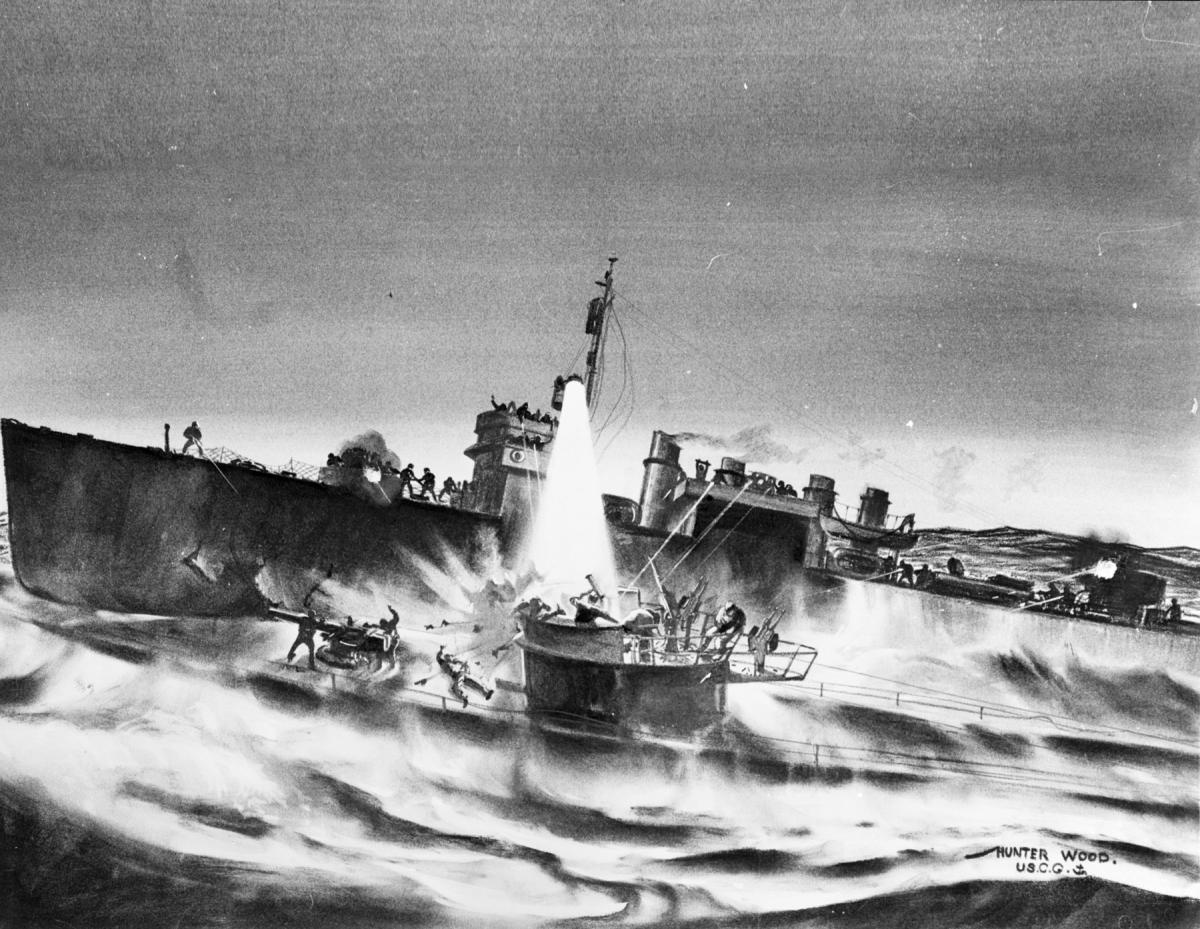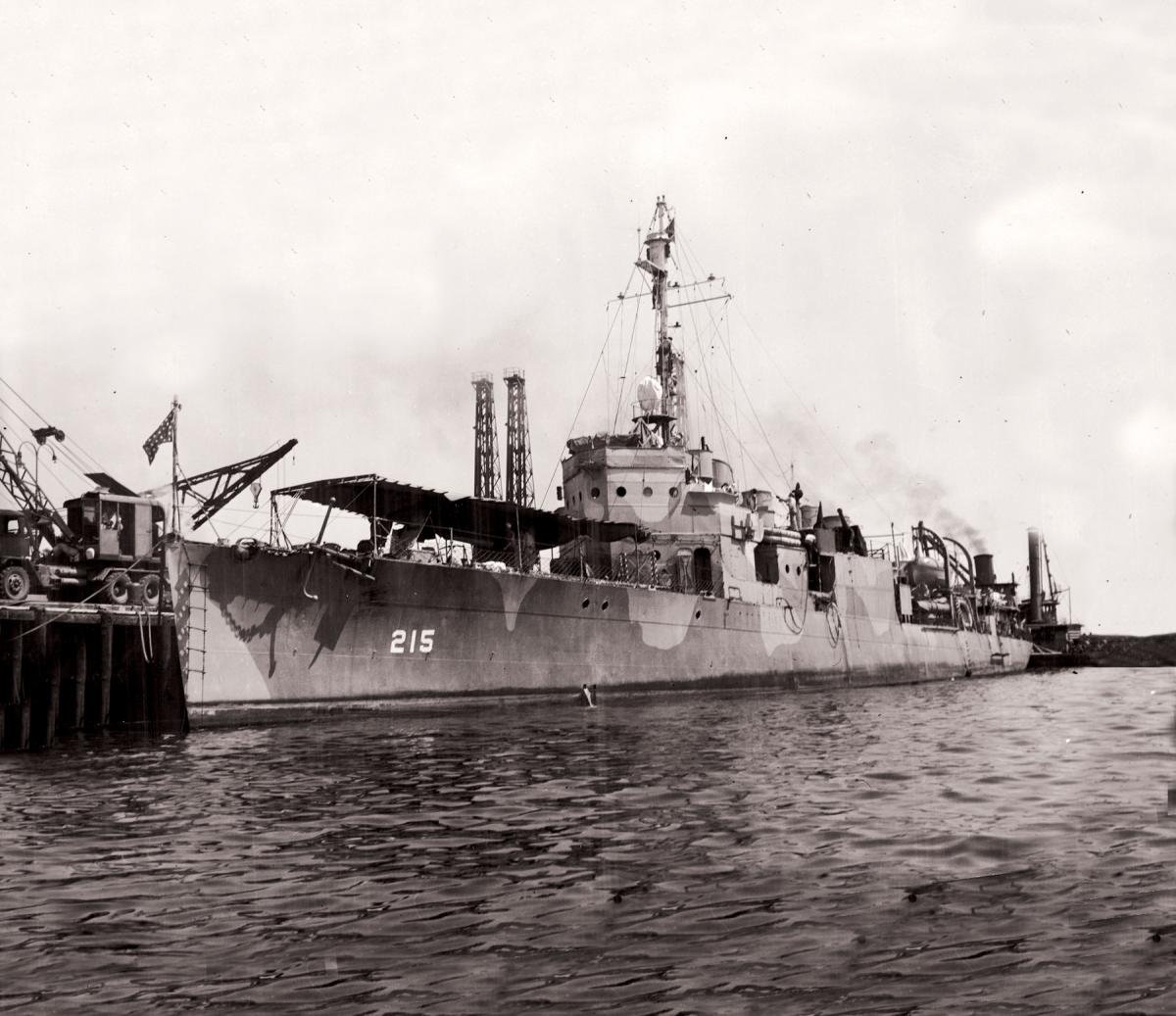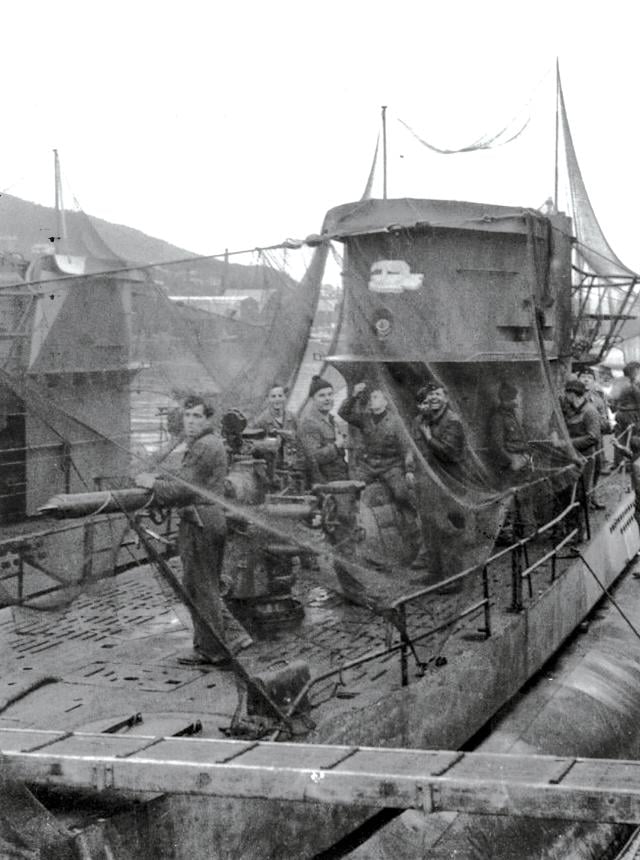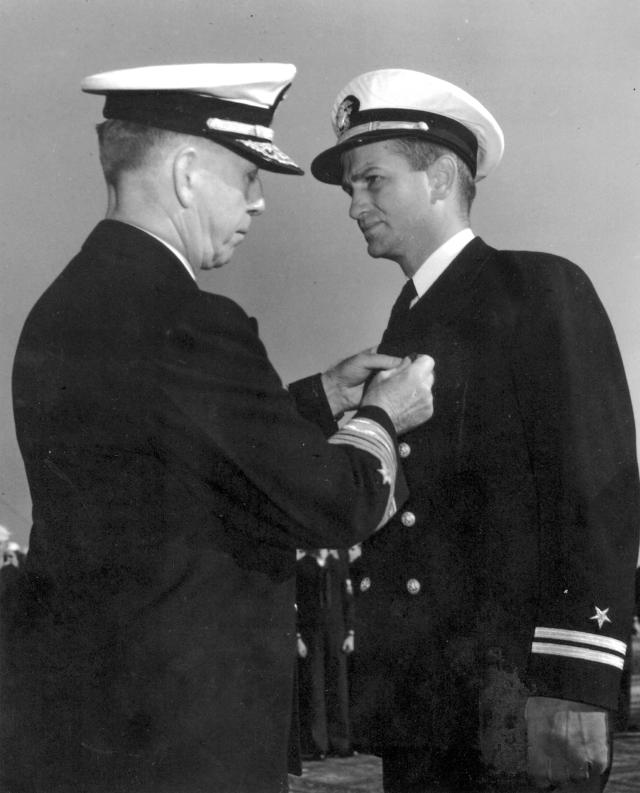U-boats and Allied destroyers typically fought with torpedoes and depth charges during the Battle of the Atlantic. But in the early hours of 1 November 1943, ramming, shotguns, shell casings, and even a sheath knife also came into play during a 64-minute free-for-all between the USS Borie (DD-215) and U-405. The gripping duel, during which each vessel’s crew demonstrated skill, courage, and tenacity, is an example of what a U.S. Navy junior officer can accomplish on his own initiative when taking his ship in harm’s way.
A Tin Can and Her Crew
The Borie was a Clemson-class flush-deck destroyer commissioned in 1920. She had plied the Black, Mediterranean, and Caribbean seas as well as the Atlantic and Pacific oceans before her fateful battle with U-405. Two refits prior to the fight had transformed the Borie from a mediocre warship into a submarine killer. The ship’s main armament of four 4-inch/50-caliber guns as well as two depth-charge tracks at her stern remained, but SL surface-search radar was installed, and two of her four triple-tube torpedo mounts were removed to help make room for six 20-mm Oerlikon guns and six depth-charge projectors.
Her captain, Lieutenant Charles Hutchins, had graduated from the U.S. Naval Academy in 1936. He served two years on active duty, during which time he got married, and then resigned his commission and moved back to Terre Haute, Indiana. Following the Pearl Harbor attack, Hutchins was commissioned a lieutenant (junior grade) in the U.S. Naval Reserve. He joined the Borie as executive officer in October 1942 and was promoted to captain in June 1943. The 30-year-old reportedly was the Navy’s youngest destroyer skipper at that time.
The Borie’s crew were mostly reservists who had served together for three years. Fire Controlman First Class Bob Maher, a reservist who had first come on board in November 1940, painted a picture in his memoir of a well-run, if not exactly spit-and-polish, ship. He was the pointer on the ship’s fire control director. From his battle station above the bridge and directly below the Borie’s 24-inch searchlight, Maher would have a box seat for the battle to come.
In early 1943, the Borie was assigned to Captain Albert J. Isbell’s Task Group 21.14, which was built around the escort carrier USS Card (CVE-11) and also included the Clemson-class destroyers Goff (DD-247) and Barry (DD-248). After escorting Atlantic convoys, the group headed north, past the Azores, in late October, as a hunter-killer group on the prowl for U-boats.
Meanwhile, U-405 was operating as part of a six-boat wolf pack, Siegfried 1. A Type VIIC submarine, U-405 had four torpedo tubes forward and one aft and typically carried 14 reliable 21-inch electric G7e model torpedoes. Topside, she mounted an 88-mm/45-caliber deck gun forward for surface engagements and four 20-mm single guns and a quad-mount 20-mm on the “wintergarden” behind the conning tower for antiaircraft defense.
Well-liked by his crew, U-405’s skipper, 37-year-old Kor -vetten Kapitain Rolf-Heinrich Hopmann, was a veteran of all seven of the submarine’s war patrols. When the boat sortied from Saint-Nazaire, France, on her eighth and final patrol on 10 October 1943, 49 officers and enlisted men were on board. After operating as part of the 23-boat wolf pack Siegfried, Hopmann’s vessel deployed with Siegfried 1 on 27 October. When the wolf pack dispersed three days later, scoreless, U-405 headed for a midocean refueling area and her rendezvous with destiny.
The First Attack
At sunset on 31 October 1943, Lieutenant Hutchins received orders for the Borie to investigate an attack report by aircraft from the Card. The planes had sunk one U-boat, but a second one, which they suspected was a tanker and resupply boat, had escaped. Captain Isbell wanted that vessel found and dispatched. The Borie steamed southward at 22 knots in relatively calm seas to do just that. The crew was eager for action—and they would get plenty. “We young bucks, dumb and happy, were really excited,” Maher wrote. “We were the hunters, not the hunted, and it was an exhilarating feeling for all of us.”
At 2010, the Borie got a radar contact at a range of 6,500 yards and accelerated to 27 knots. The target was U-256, a VIIC boat converted to an antiaircraft submarine, or U-flak. Quickly closing the distance, the Borie fired a salvo of star shells from a range of 1,700 yards, illuminating U-256 and driving her underwater. The destroyer closed and delivered a depth-charge attack. Soon after, a mysterious heavy underwater explosion temporarily knocked out the Borie’s sound gear.
Frantic work brought the gear back on line, and ten minutes later, the Borie again made sonar contact and dropped depth charges. The cumulative effect of the attacks was to force the boat to the surface. But before the Borie could engage her with gunfire, U-256 submerged. After regaining sound contact, the destroyer delivered a third depth-charge attack. Even though she remained in the area searching for more than three hours, the ship was unable to reestablish contact. Her crew noted the strong smell of fuel oil and a large slick, and Hutchins reported to the Card: “Scratch one pig boat eleven miles south of your position. Am searching for more.” Although the destroyer had damaged U-256, she had not sunk her. The submarine managed to limp back to Brest, France.
A Second Contact
he Borie continued south for less than an hour through worsening seas before her surface-search radar picked up a second contact, U-405, at a range of 8,000 yards. Accelerating to 27 knots, the Borie swiftly closed on her prey, which disappeared from the destroyer’s radar screen at 2,800 yards as she submerged. The Borie slowed, gained a sound contact, and delivered a depth-charge attack during which a malfunction caused the entire contents of both stern tracks to empty at once. Besides lifting the Borie’s stern out of the water, the explosive force drove U-405 to the surface.
Using radar bearings, the Borie’s searchlight swiftly illuminated the boat. The destroyer would keep U-405 lit up for the entire fight, with one brief exception. Maher noted that the illumination allowed him to see that the conning tower of the light gray submarine bore the polar bear insignia of the 11th U-boat Flotilla. As the Borie closed on the boat, which evidently was unable to submerge, the destroyer’s guns began to engage independently as they came to bear.
German sailors scrambled to man their deck guns amid the destroyer’s deadly hail of fire. Some managed to hit the Borie with a few 20-mm rounds before being killed by the murderous return fire. Although other German sailors courageously tried to fire back, almost all were slain before they could man their guns. The 88-mm deck gun never got a round off. The first director-controlled salvo by three of the U.S. ship’s 4-inchers literally blew the gun into the ocean.
Twisting U-405 like an eel, Korvetten Kapitain Hopmann used her superior maneuverability to try to flee on the surface. Nevertheless, Hutchins displayed fine seamanship and the Borie stuck with her opponent, pounding her mercilessly. At one point, U-405 shot off a number of Very pistol flares and a sailor stood on the conning tower waving his arms as if asking the Americans to stop shooting. Lieutenant Hutchins accordingly ordered his guns to cease fire. But the gun captain of a galley deckhouse 4-inch gun had removed his headphones. His gun continued to fire, decapitating the gesticulating German sailor. As Maher related, “It was a sight that was to give me nightmares for months.” U-405 again began to maneuver and the battle continued.
A Lethal Embrace
A few minutes later, Hutchins’ command echoed through the Borie: “Stand by for a ram!” Determined not to let U-405 escape, the Borie closed on her starboard quarter at 25 knots. Hopmann tried to avoid the blow but started his turn too late. A sudden wave lifted the Borie up, and she crashed down on U-405’s deck between forecastle and stem at a 30-degree angle. For the next ten minutes, they would be locked together in a lethal embrace.
Within seconds of the collision, the Borie’s crew put into action a drill that the executive officer, Lieutenant Phillip B. Brown, repeatedly had run during the past few months. With the exception of the black gang (the engine room and fire room crew) and the gun crews, as many as possible of the rest of the ship’s company armed themselves with a variety of weapons ranging from Thompson submachine guns to shotguns to pistols. They took station on the port side and added their fire to that of the 20-mm Oerlikons and 4-inch guns. Any submariner who braved that hail of fire died before returning a shot.
Two incidents illustrate the ferocity of the encounter while the two ships were locked together. In the first, Fireman First Class David Southwick threw his sheath knife at a German sailor less than ten yards away, killing him. In the second, Chief Boatswain’s Mate Walter Kruz hurled a 4-inch shell casing at a different German, knocking him into the frigid water.
While the battle raged topside, the black gang became engaged in a desperate battle belowdecks. The grinding of the Borie’s hull plating, already worn thin by 23 years of continuous service, against the U-boat compromised structural integrity. When the two vessels finally separated, Captain Hutchins became aware of the seriousness of the damage. He later reported: “The entire port side, from bow to after end of the ‘D’ tanks was badly crushed and holed. The forward engine room flooded completely in spite of all efforts to prevent it.” As the flooding worsened, a damage control party joined the black gang as they strove to keep back the sea. Together they managed to keep both engine rooms manned throughout the rest of the battle—even to the point of operating the forward engine in neck-deep cold water.
More Fighting, Then Victory
By the time the Borie slid off the submarine, about 35 of U-405’s crewmen were out of action. Hopmann managed a series of evasive maneuvers in an attempt to escape and opened the range to around 400 yards. That allowed the Borie to engage with coordinated 4-inch salvos. One struck the sub’s starboard diesel exhaust and may have penetrated the aft torpedo room. The Borie then fired a torpedo at U-405, but in the increasingly heavy seas, it missed.
The submarine next began turning in a tight circle, and the destroyer, because of her very wide turning radius, was unable to close. During this maneuvering, Lieutenant Hutchins realized that the U-405’s stern tube was continually pointing at the Borie. He ordered the searchlight extinguished to reduce the possibility of taking a torpedo from the “stinger” tube and in the hope that the boat would try to escape in the darkness and he could reengage her. It worked. The Borie bent on 27 knots to pursue, illuminating U-405 once again. Now on a collision course, the boat gamely attempted to ram the Borie on her starboard side.
Hutchins wrote in the after-action report, “Borie immediately turned hard left, backing full on port engine throwing stern toward sub, to bring it in range of projectors and fired starboard depth charge battery.” Three depth charges set for 30 feet straddled the conning tower, bringing the stem of the U-boat to a stop six feet from the Borie’s starboard side. Once again, the German tried to flee, but at considerably reduced speed.
The Borie launched another torpedo, which missed the U-boat’s bow by ten feet. Since the range had once more opened to 700 yards, 4-inch salvos again struck U-405. One such barrage delivered the coup de grace, blasting the starboard diesel exhaust again. The battered U-boat glided to a stop and surrendered. On board the Borie, Hutchins later wrote, “there was a yell that went up from all hands—it probably could be heard in Berlin.” U-405 fired off a shower of white, red, and green Very pistol flares, while about 15 of her battered crewmen made their way into yellow rubber rafts.
As they prepared to collect the U-405 survivors, the Borie’s crew noticed that the occupants of the life rafts continued to fire off Very rounds. Alarmingly, these were answered from a distance by a similar flare display. Shortly thereafter, the destroyer’s sound operator heard a torpedo headed in the ship’s direction. The Borie narrowly avoided it, with a number of the crew observing the torpedo’s wake as it went down the port side. Already severely damaged and in no condition to battle a third U-boat, the destroyer cleared the area, making radical zigzags—and in the process unavoidably steaming through the group of U-405 survivors—as she headed to the northwest at best possible speed.
The Final Battle
In many ways, the fight to keep the badly damaged Borie afloat in seas that had increased to 40 feet rivals the drama of the battle. The black gang abandoned the now-flooded forward engine room but, aided by a damage control party, managed to keep the fire room and the rear engine room operating so the ship could still make way.
The flooding of the forward engine room, however, resulted in the loss of all generators and electrical power. The crew worked through the night throwing anything they could overboard to lighten the ship, including the 20-mm guns, torpedoes and tubes, all but ten rounds of ammunition for each 4-inch gun, and the one-ton gun director.
By dawn on 1 November, only one engine was working, and saltwater had contaminated the ship’s fuel and the water supply for her boilers. At 0900, the last turbine seized from the accumulation of salt. Alone and unable to maneuver in sub-infested waters, the Borie was in desperate straits. Lieutenant Hutchins decided to call for help, but the radio had no power. All of the gasoline had been used to run pumps.
Undaunted, the radiomen used lighter fluid, kerosene, and rubbing alcohol to get the Kohler auxiliary generator working. At 1110, the Card received the destroyer’s message “commenced sinking.” Captain Isbell promptly ordered the Barry and Goff to light off all boilers to rush to the Borie’s rescue as soon as she could be located. The Card launched two aircraft, which found the stricken destroyer 14 miles away on a bearing of 052 degrees true.
The Goff dashed off, leaving the Barry to escort the Card. Arriving just before noon, the Goff immediately began attempts to aid the dead-in-the-water destroyer, but the efforts were doomed by the heavy seas. Unable to come alongside, the Goff and then the Barry were only able to stand by to take on survivors. At 1630, Lieutenant Hutchins gave the order to abandon ship, and men began going over the side at 1644.
Remarkably, the Borie’s crew had suffered no serious casualties during its battle with U-405. But, as Hutchins related in a filmed interview:
This maneuver, this abandoning ship, resulted in the loss of 24 men and 3 officers. The temperature of the water was 44 with very cold air, the seas were very high and, although the abandoning was very orderly, when the rafts got alongside the rescue ships the rolling and the pitching of those ships resulted in the loss of men.
He commended both the Goff and Barry for their outstanding seamanship and rescue work.
Hutchins closed by saying: “However, the conditions were such that these men who had no sleep since the previous night, who had fought the action all night, and many who has spent the balance of the night and day in controlling damage, many of them lost were just unable to get over the side.” Bob Maher wrote that he was the last survivor plucked, nearly frozen, from the sea. In all, 125 enlisted men and 4 officers survived the battle and were rescued. The next morning, the Borie was still afloat. Captain Isbell ordered the task force to sink her, and a combination of gunfire and aircraft-administered depth charges finally sent the Borie to the bottom.
The struggle between the USS Borie and U-405 shows the grit and determination of both sides in the Battle of the Atlantic. It also demonstrates what a junior officer—Lieutenant Charles Hutchins—a crew composed largely of reservists, and a World War I–era ship can accomplish in the heat and aftermath of combat. More than 75 years after the contest, their story can still inspire naval officers facing the test of battle.
Sources:
Destroyer Escort Historical Museum, USS Slater (DE-766), www.ussslater.org.
USS Borie (DD-215), Dictionary of American Naval Fighting Ships online, Haze Gray and Underway, www.hazegray.org/danfs/.
Jonathan Dimbleby, The Battle of the Atlantic: How the Allies Won the War (New York: Oxford University Press, 2016).
LCDR Bruce E. Grooms, USN, Critical German Submarine Operations versus Allied Convoys during March 1943: An Operational Analysis (Pickle Partners Publishing, 2014).
B. H. Liddell-Hart, History of the Second World War (New York: G. P. Putnam & Sons, 1970).
LCDR Charles H. Hutchins, USNR, “Report of Anti-Submarine Action by USS BORIE, 31 October, and 1 November 1943,” Record Group 31, National Archives and Records Administration, College Park, MD (hereafter NARA).
LCDR Charles H. Hutchins, USNR, “Sinking of Submarine in North Atlantic Convoy,” World War II Oral Histories, Interviews and Statements, Record Group 38, NARA.
Robert A. Maher and CAPT James E. Wise Jr., USN (Ret.), Sailor’s Journey into War (Kent, OH: The Kent State University Press, 1998).
Samuel Eliot Morison, The Battle of the Atlantic ,1939–1943, vol. 1, History of United States Naval Operations in World War II (Boston: Little, Brown and Company, 1955, rev. ed.).
Samuel Eliot Morison, The Atlantic Battle Won, May 1943–May 1945, vol. 10, History of United States Naval Operations in World War II (Boston: Little, Brown and Company, 1975, reprint ed.).
Axel Niestle, German U-Boat Losses during World War II: Details of Destruction (Annapolis, MD: Naval Institute Press, 1998).
Barrie Pitt, The Battle of the Atlantic (Alexandria, VA: Time-Life Books, 1980).
Radar Research and Development Sub-Committee of the Joint Committee on New Weapons and Equipment, “Operational Characteristics of Radar,” FTP 217, 1 August 1943, Naval History and Heritage Command, www.history.navy.mil/research/library/online-reading-room/title-list-alphabetically/u/operational-characteristics-of-radar-classified-by-tactical-application.html.
CDR Herbert A. Werner, Kriegsmarine, Iron Coffins: A Personal Account of the German U-Boat Battles of World War II (Cambridge, MA: Da Capo Press, 2002, reprint ed.).
E. Andrew Wilde Jr., The USS Borie (DD-215) in World War II: Documents and Photographs (Needham, MA: Published privately by the author, 2001).
Andrew Williams, The Battle of the Atlantic: Hitler’s Gray Wolves of the Sea and the Allies Desperate Struggle to Defeat Them (New York: Basic Books, 2003).
Gordon Williamson, U-boat Tactics in World War II (Oxford, UK: Osprey Publishing, Ltd., 2010).






